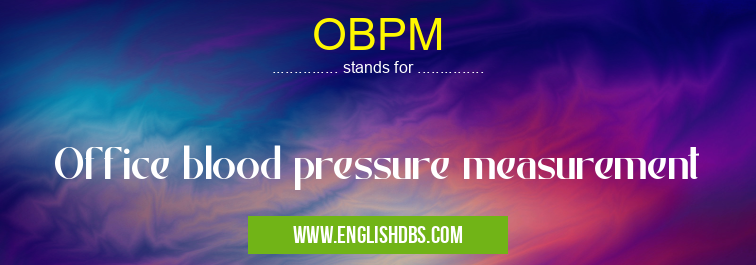What does OBPM mean in NURSING
OBPM is a method of measuring blood pressure during a medical visit in a doctor's office or clinic. It involves using a sphygmomanometer, which consists of an inflatable cuff placed around the upper arm and a gauge to measure the pressure inside the cuff.

OBPM meaning in Nursing in Medical
OBPM mostly used in an acronym Nursing in Category Medical that means Office blood pressure measurement
Shorthand: OBPM,
Full Form: Office blood pressure measurement
For more information of "Office blood pressure measurement", see the section below.
OBPM Meaning in Medical
- OBPM is a crucial component of the initial evaluation and follow-up care for individuals with suspected or confirmed hypertension.
- It provides a snapshot of a person's blood pressure under controlled conditions and helps determine the need for further evaluation or treatment.
OBPM Full Form
- Office Blood Pressure Measurement
What does OBPM Stand for?
- Office Blood Pressure Measurement
Conclusion:
- OBPM is a widely used method for assessing an individual's blood pressure.
- It is important for individuals to have regular OBPM checks to monitor their blood pressure and maintain optimal cardiovascular health.
Essential Questions and Answers on Office blood pressure measurement in "MEDICAL»NURSING"
What is office blood pressure measurement (OBPM)?
Why is OBPM important?
OBPM helps healthcare providers assess a person's blood pressure and diagnose hypertension, also known as high blood pressure. Hypertension is a major risk factor for heart disease, stroke, kidney disease, and other health problems.
How is OBPM performed?
OBPM is typically performed while the person is seated with their arm resting on a table or support. The cuff is placed snugly around the upper arm, and the gauge is used to inflate the cuff until the blood flow in the brachial artery is blocked. The pressure is then slowly released, and the healthcare provider listens for sounds called Korotkoff sounds through a stethoscope placed over the brachial artery. These sounds indicate the systolic and diastolic blood pressure readings.
What is the difference between systolic and diastolic blood pressure?
Systolic blood pressure is the pressure in the arteries when the heart beats and pumps blood out. Diastolic blood pressure is the pressure in the arteries when the heart rests between beats. Both are important for determining overall heart health.
What are normal OBPM readings?
For adults, normal OBPM readings are:
- Systolic: 120-129 mm Hg
- Diastolic: 80-89 mm Hg Readings that are consistently higher than these levels may indicate hypertension.
